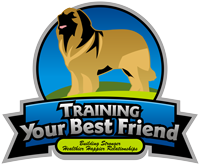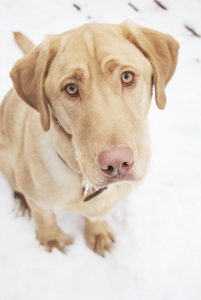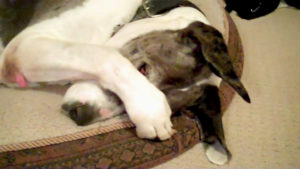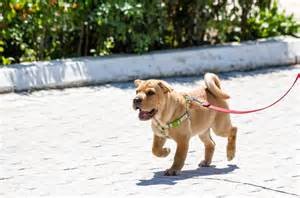
Leash Walking – Nothing Natural About It
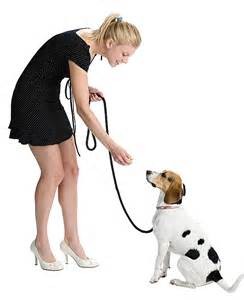 Always remember when leash walking is not going well, you can stop, stand still and wait – for attention from your dog. You cannot expect to be successful walking if you can’t maintain your dog’s attention standing still.
Always remember when leash walking is not going well, you can stop, stand still and wait – for attention from your dog. You cannot expect to be successful walking if you can’t maintain your dog’s attention standing still.
So you have your dog’s attention, great! Let’s walk, easy right? Probably not! You start walking and your dog lunges in front of you. Why you ask, what happened to that nice attention? You forgot to pay for it! Remember leash walking is not natural, and you have to make it worth the dog’s effort. The biggest problem I see with leash walking is people being “cheap” with their rewards/pay checks to the dog. They are expecting too much from the dog before rewarding.
In the trainer world we talk about don’t lump behaviors together, you need to split them into small bits. You want small bits for your learner (in this case the dog) can be successful. If you lump too many behaviors together, you end up frustrating both the trainer and the learner since no one is being successful. For leash walking the first split of behavior is the attention – see you were splitting and you didn’t even know it!
The next split I find is rewarding the moment you step off. Not three steps down the sidewalk. I find that in the beginning rewarding LITERALLY every step of a walk is what is needed with most dogs. In addition to every step, most dogs need a high value reward – think chicken, cheese, hot dogs, etc. To help this along I would suggest using a waist leash and filling both your hands with treats. With your dog on your side (whatever side you prefer) start walking and every time your right foot lands feed one cookie out of your right hand. Then when your left foot lands, feed out of your left on. Now just keep on walking like this, every step a cookie gets offered to your dog. If you have the right value of reward your dog should be right where you want them. Why would they not be next to you, if they know in half a second you are going to reward them again. I call this the “pez dispenser” method of teaching leash walking. You now have become a human pez dispenser! If your dog is not where you want them with every step, either your reward is not valuable enough for the situation, you are training in too distracting of an environment or you have been training for too long. Over a period of time, (days, weeks, months?) you will start adding additional steps before feeding. Only when you have multiple outings where you can’t loose your dog. You will go from 1 step feed, then 2 steps feed, then 3 steps, etc. If you loose your dog’s attention then go back to the number of steps you were successful. There is no point to walking when you don’t have your dog’s attention.
Another spilt tip for walking, involves a different way to quickly reward. I think of this game as the “don’t wait for a mistake and a reset to reward”. I frequently will use a high value treat such a cheese, hot dogs, turkey or chicken as a marker for good behavior while training. So here is the training scenario I use for Mckenna, who gets a little anxious on walks when meeting strangers. Mckenna, gives me attention, I speak her name and then I treat. While she is eating she usually does not look at me, but she has not lost total attention on me. So I quickly say her name again, since she is being correct. She is walking near me, and not pulling, maybe a stride or two ahead. when she relaxes I allow her to get to the end of leash. Mckenna usually is happily startled, to be rewarded again so quickly. I can see the wheels turning to try and figure out what earned her that reward. We do this time and time again, and we are in a happy successful loop of speak, treat, eat, speak treat eat. Over time this has helped her learn how not to get to the end of his leash and therefore not pull, and everyone is happy!
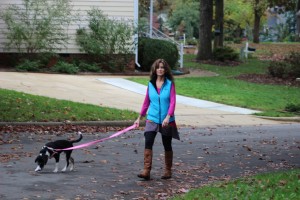 The reason I started the “don’t wait for a mistake and a reset” training game, is completely in the name. So often I see people reward their dog for the attention, while the dog is actively enjoying their reward they “get lost” in the moment and are no longer walking well. The person keeps walking, the dog gets ahead of the person, then the dog gets to the end of the leash, which has become a cue to get closer to the owner. The dog “self corrects” their walking manners and gets closer and/or pay attention again, and the owner rewards. Now the dog is a different behavior loop of I get to the end of my leash, I get closer to my person, I get rewarded, so I go to the end of my leash to get closer to get my reward. This is not such a happy behavior loop as above.
The reason I started the “don’t wait for a mistake and a reset” training game, is completely in the name. So often I see people reward their dog for the attention, while the dog is actively enjoying their reward they “get lost” in the moment and are no longer walking well. The person keeps walking, the dog gets ahead of the person, then the dog gets to the end of the leash, which has become a cue to get closer to the owner. The dog “self corrects” their walking manners and gets closer and/or pay attention again, and the owner rewards. Now the dog is a different behavior loop of I get to the end of my leash, I get closer to my person, I get rewarded, so I go to the end of my leash to get closer to get my reward. This is not such a happy behavior loop as above.
I hope these give you some ideas on how to get started on good polite walking with your dog!
Toddlers don’t learn how to walk in a day, don’t expect more from your dog.
Remember practice makes perfect for both you and your dog, this is not a skill that comes naturally for either of you.
Finally, remember to have FUN with your dog training. If you are getting frustrated with the walking process take a break. Make it easier for your dog or go train something else for a little while.

